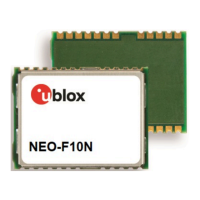NEO-F10N-Integration manual
Figure 12: Tape dimensions (mm)
5.2.3 Moisture sensitivity level
The moisture sensitivity level (MSL) for NEO-F10N modules is specified in the table below.
Package MSL level
LCC (professional grade) 4
Table 12: MSL level
For MSL standard see IPC/JEDEC J-STD-020, and J-STD-033 that can be downloaded from
www.jedec.org. For more information regarding moisture sensitivity levels, labeling, storage and
drying, see the u-blox packaging information reference [4].
5.2.4 Soldering
Reflow soldering procedures are described in the IPC/JEDEC J-STD-020 standard.
When populating the modules, make sure that the pick and place machine is aligned to the
copper pins of the module and not to the module edge.
Soldering paste
Use of “no clean” soldering paste is highly recommended, as it does not require cleaning after the
soldering process. The paste in the example below meets these criteria.
• Soldering paste: OM338 SAC405 / Nr.143714 (Cookson Electronics)
• Alloy specification: Sn 95.5/ Ag 4/ Cu 0.5 (95.5% tin/ 4% silver/ 0.5% copper)
• Melting temperature: 217 °C
• Stencil: The exact geometry, distances, stencil thicknesses and solder paste volumes must be
adapted to the customer's specific production processes.
Reflow soldering
A convection-type soldering oven is highly recommended over the infrared-type radiation oven.
Convection-heated ovens allow precise control of the temperature, and all parts will heat up evenly,
regardless of material properties, thickness of components and surface color.
As a reference, see “IPC-7530 Guidelines for temperature profiling for mass soldering (reflow and
wave) processes”, published in 2001.
Preheat phase
UBXDOC-963802114-12193 - R02
5 Product handling Page 30 of 42
C1-Public

